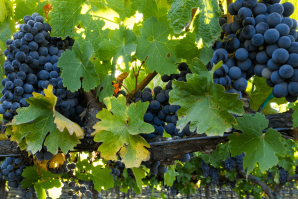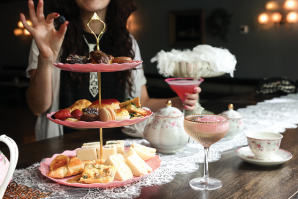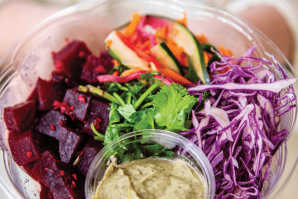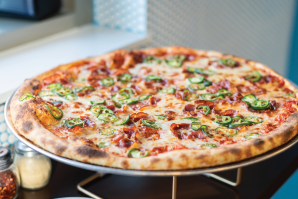The canned alcohol trend isn’t hard to spot. Just stroll through your local grocery store and you’ll see those colorfully packaged cans of prosecco and prickly pear margaritas all dressed up and ready to go, perfect for a picnic or poolside party.
Industry experts call it the RTD, or ready-to-drink, market that just keeps getting bigger. Partly an outgrowth of the pandemic, when bars were closed and people were imbibing at home, and partly for reasons of convenience, canned alcohol sales are on the rise. A 2024 report by the Business Research Company predicts this sector’s market size will reach $13.37 billion by 2028, at a compound annual growth rate of 13.9 percent. Sales of canned cocktails alone have increased more than 200 percent in recent years, according to another report.
These are global numbers, but they reflect a local trend. “The popularity of canned alcohol is just nuts,” says Celeste Dolan, specialty beverage account manager of The Can Van, a Sacramento-based mobile canning service and the first of its kind in the world.
Lindsey Herrema operates the canning line. (Photo courtesy of The
Can Van)

“It’s this evolution of commodities that have become more popular in the can,” says Dolan. “The wine space has grown considerably, and craft cocktails as well.”
Dolan likens the canned cocktail boom to that of craft beer 10 years ago. “It’s like, ‘Let’s get those cocktails in a can,’” she says.
Canned wines have taken the longest to make the transition. But consumers — and winemakers — are coming around.
“With winemakers there’s a lot of loyalty to the history of winemaking, so bottles are always the go-to,” says Dolan. “But we’re noticing that a lot of the OG winemakers are starting to consider cans. It’s not as taboo anymore.”
Sustainability is the driving factor for many, Dolan says. Glass bottles, and their shipping and transport, are the biggest contributor to the wine industry’s carbon footprint, prompting winemakers to consider more eco-friendly alternatives.
One local winery making a giant leap in that direction is Bogle Family Vineyards. With six generations of family and more than 50 years of winemaking in the Delta town of Clarksburg, Bogle is steeped in old-school tradition. But they’ve also been long committed to sustainability, according to Jody Bogle, co-owner and vice president of consumer relations. Toward that end, Bogle introduced in January a new line, Element[AL], featuring four varietals packaged in elegant, lightweight aluminum cans shaped like traditional wine bottles.
Bogle Family Vineyards introduced a new line, Element[AL],
featuring four varietals packaged in elegant, lightweight
aluminum cans shaped like traditional wine bottles. (Photo
courtesy of Bogle Family Vineyards)
![Bogle Family Vineyards introduced a new line, Element[AL], featuring four varietals packaged in elegant, lightweight aluminum cans shaped like traditional wine bottles. (Photo courtesy of Bogle Family Vineyards)](/sites/main/files/imagecache/medium/main-images/element_al1287_pinot_noir_v1b.png?1715890111)
The beauty of aluminum, Bogle says, is its exquisite lightness. Element[AL]’s bottles are 80 percent lighter than glass — a boon for the environment and a breeze for consumers to tote. They are also 100 percent recyclable.
But even with such compelling upsides, Bogle admits, she initially had her doubts.“When we first started the project, I’ll be honest — I wasn’t 100 percent sold,” she says. “I wasn’t sure there was a future for this.”
But while conducting focus groups, Bogle’s confidence grew. “One woman initially said ‘I’d never drink wine in aluminum — never.’ But 10 minutes later she had the bottle in her hand and said, ‘Oh gosh, it’s beautiful — it looks like Dior! I’d buy it by the case.’”
Research shows consumers are getting more comfortable sipping wine from aluminum. The canned wine market is expected to reach more than $571 million globally by 2028 — a 13 percent jump from 2021.
Most conventionally, canned wines are downsized for quick consumption, with 375 milliliters (ml), about two glasses of wine, a popular size. An even smaller 250ml is common among Can Van clients, according to Dolan. “That’s a third of a bottle, or about one-and-a-half glasses,” she says.
Bogle went against that industry standard with its Element[AL] wines, whose bottles hold 750ml, the same as traditional glass bottles. Though the aluminum bottles are smaller in size, they are able to contain the same amount of liquid, Bogle explains, due to thinner walls and a very small punt — the concave at the bottom. “There’s a lot of benefit in having the same volume of wine in a smaller package,” she says.
But the wine itself, Bogle says, is entirely different. “These are not Bogle wines poured into a different bottle,” she says. “These wines were specifically created for the Element[AL] program.”
They also come at a higher price point than other Bogle wines — $16.99 as compared to the $12–$16 of a traditional bottle of Bogle — a difference Bogle attributes not only to packaging, but to quality.
“These are not simple wines; these are elegant, elevated wines,” she says. “We’re challenging people to expect more from their wine in aluminum.”
–
Subscribe to the Comstock’s newsletter today.
Recommended For You

Putting North American Grapes on the (Genetic) Map
UC Davis research on native grapes may help winegrowers adapt to climate change
UC Davis researchers have created the first ever comprehensive pangenome for North American grapes, a blueprint that will allow breeders to select rootstock by its genetic propensity for specific desired traits — say, drought tolerance or heat resistance.

Is Tea the New Happy Hour?
These Capital Region tea rooms bring a California twist to an English tradition
Afternoon tea evokes something people have always sought — “a feeling of rarely experienced elegance and class,” Mueller says.

Reset and Drink Up
These Capital Region cafes offer food and drink with a side of health care
Across the region, health food businesses are branching beyond acai bowls and chia-seed puddings to offer customers a broader spectrum of health programs and treatments. From juice cleanses to lattes with a side of ionic detoxification, the spread of these businesses demonstrates that customers are willing to invest in their health — and are looking beyond the traditional health care system to do so.

Reeling Them In
Local restaurants use Instagram Reels and TikTok to attract customers
Your experience of social media may be as a fun time-waster, an angst-producing FOMO (fear of missing out) machine or the reason you know your Uncle Dennis believes in ancient aliens. But to many restaurant owners, social media is a necessity.



